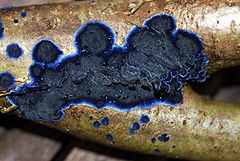
Corticioid fungi
Encyclopedia

Basidiomycota
Basidiomycota is one of two large phyla that, together with the Ascomycota, comprise the subkingdom Dikarya within the Kingdom Fungi...
typically having effused, smooth basidiocarps (fruit bodies) that are formed on the undersides of dead attached or fallen branches. They are sometimes colloquially called crust fungi or patch fungi. Originally such fungi were referred to the genus
Genus
In biology, a genus is a low-level taxonomic rank used in the biological classification of living and fossil organisms, which is an example of definition by genus and differentia...
Corticium
Corticium
Corticium is a genus of crust fungi in the family Corticiaceae. According to a 2008 estimate, the genus contains 25 widely distributed species.-Species:*Corticium appalachiense*Corticium auberianum*Corticium boreoroseum...
("corticioid" means Corticium-like) and subsequently to the family
Family (biology)
In biological classification, family is* a taxonomic rank. Other well-known ranks are life, domain, kingdom, phylum, class, order, genus, and species, with family fitting between order and genus. As for the other well-known ranks, there is the option of an immediately lower rank, indicated by the...
Corticiaceae
Corticiaceae
The Corticiaceae are a family of fungi in the order Corticiales. The family formerly included almost all the corticioid fungi, whether they were related or not, and as such was highly artificial...
, but it is now known that corticioid species are not closely related. The fact that they look similar is an example of adaptive evolution. Since they are often studied as a group, it is convenient to retain the informal (non-taxonomic) name of "corticioid fungi" and this term is frequently used in research papers and other texts.
History
The genus Corticium was established by Persoon in 1794 for fungi having smooth, effused fruit bodies. Corticium roseum Pers. was later selected as the type species. Subsequent authors described over 1000 species in the genus which continued to be used in its wide sense up until the 1950s. Though a number of genera had been recognized as distinct from Corticium from the late nineteenth century onwards, it was not until Swedish mycologist Prof. John Eriksson reviewed the corticioid fungi in a series of publications starting in 1950 that modern concepts were formed. The eight-volume work that he initiated, Corticiaceae of North Europe (1973-1987), effectively established the current circumscription of the corticioid fungi.Eriksson and his co-authors, however, still placed all or most of these fungi within the Corticiaceae, though stating that this was "not a natural taxon but an assemblage of species with similar habitat." It was not until the advent of DNA sequencing that the full diversity of these fungi was realized. The genus Corticium is still retained, but is now restricted to a few species closely related to the type. The Corticiaceae is now equally restricted to a few genera close to (and including) Corticium.
Description and diversity

Stereum
Stereum is type genus of the Stereaceae family of fungi, in the Russulales order. Until recently, the genus was classified in the Corticiaceae family, of the Corticiales order. However, it was given its own family as a result of the split-up of the Corticiales. Common names for species of this...
and Steccherinum
Steccherinum
Steccherinum is a genus of fungi in the Meruliaceae family. The genus has a widespread distribution, and contains 33 species.-Species:*Steccherinum aggregatum*Steccherinum alaskense*Steccherinum albidum*Steccherinum albofibrillosum...
, for example) may form fruit bodies that are partly bracket- or shelf-like with a smooth to spiny undersurface.
The corticioid fungi currently comprise around 1700 species worldwide, distributed amongst some 250 genera. They constitute around 13% of the homobasidiomycetes known to date.
Habitat and distribution
Most corticioid fungi are wood-rottingWood-decay fungus
A wood-decay fungus is a variety of fungus that digests moist wood, causing it to rot. Some wood-decay fungi attack dead wood, such as brown rot, and some, such as Armillaria , are parasitic and colonize living trees. Fungi that not only grow on wood but actually cause it to decay, are called...
species, growing on the undersides of dead attached branches or on logs and fallen branches. A few are litter-rotting and produce fruitbodies underneath fallen leaves and compacted litter as well as on fallen wood. Some of these species are known to be ectomycorrhizal (forming a beneficial association with the roots of living trees). A few specialist species grow on dead herbaceous stems and leaves or on dead grass, rush, and sedge stems, especially in marshes.
Corticioid fungi have a worldwide distribution, but are obviously commonest in forest communities.

